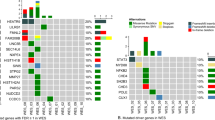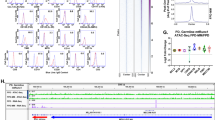Abstract
Acute promyelocytic leukemia (APL) is a medical emergency because of associated lethal early bleeding, a condition preventable by prompt diagnosis and therapeutic intervention. The mechanisms underlying the hemostatic anomalies of APL are not completely elucidated. RNA-sequencing-based characterization of APL (n = 30) was performed and compared to that of other acute myeloid leukemia (n = 400) samples and normal promyelocytes. Perturbations in the transcriptome of coagulation and fibrinolysis-related genes in APL extend beyond known culprits and now include Thrombin, Factor X and Urokinase Receptor. Most intriguingly, the Podoplanin (PDPN) gene, involved in platelet aggregation, is aberrantly expressed in APL promyelocytes and is the most distinctive transcript for this disease. Using an antibody panel optimized for AML diagnosis by flow cytometry, we also found that PDPN was the most specific surface marker for APL, and that all-trans retinoic acid therapy rapidly decreases its expression. Functional studies showed that engineered overexpression of this gene in human leukemic cells causes aberrant platelet binding, activation and aggregation. PDPN-expressing primary APL cells, but not PDPN-negative primary leukemias, specifically induce platelet binding, activation and aggregation. Finally, PDPN expression on leukemia cells in a xenograft model was associated with thrombocytopenia and prolonged bleeding time in vivo. Together our results suggest that PDPN may contribute to the hemostatic perturbations found in APL.
This is a preview of subscription content, access via your institution
Access options
Subscribe to this journal
Receive 12 print issues and online access
$259.00 per year
only $21.58 per issue
Buy this article
- Purchase on Springer Link
- Instant access to full article PDF
Prices may be subject to local taxes which are calculated during checkout





Similar content being viewed by others
References
Lo-Coco F, Avvisati G, Vignetti M, Thiede C, Orlando S, Iacobelli S, et al. Retinoic acid and arsenic trioxide for acute promyelocytic leukemia. New Engl J Med. 2013;369:111–21.
Park JH, Qiao B, Panageas KS, Schymura MJ, Jurcic JG, Rosenblat TL, et al. Early death rate in acute promyelocytic leukemia remains high despite all-trans retinoic acid. Blood. 2011;118:1248–54.
Lehmann S, Ravn A, Carlsson L, Antunovic P, Deneberg S, Möllgård L, et al. Continuing high early death rate in acute promyelocytic leukemia: a population-based report from the Swedish Adult Acute Leukemia Registry. Leukemia. 2011;25:1128–34.
Tallman MS, Kim HT, Montesinos P, Appelbaum FR, de la Serna J, Bennett JM, et al. Does microgranular variant morphology of acute promyelocytic leukemia independently predict a less favorable outcome compared with classical M3 APL? A joint study of the North American Intergroup and the PETHEMA Group. Blood. 2010;116:5650–9.
Rovelli A, Biondi A, Rajnoldi CA, Conter V, Giudici G, Jankovic M, et al. Microgranular variant of acute promyelocytic leukemia in children. J Clin Oncol. 1992;10:1413–8.
Mantha S, Tallman M, Soff GA. What’s new in the pathogenesis of the coagulopathy in acute promyelocytic leukemia?’. Curr Opin Hematol. 2016;23:121–6.
Kwaan HC, Cull EH. The coagulopathy in acute promyelocytic leukaemia—What have we learned in the past twenty years. Best Pract Res Clin Haematol. 2014;27:11–8.
Koyama T, Hirosawa S, Kawamata N, Tohda S, Aoki N. All-trans retinoic acid upregulates thrombomodulin and downregulates tissue-factor expression in acute promyelocytic leukemia cells: distinct expression of thrombomodulin and tissue factor in human leukemic cells. Blood. 1994;84:3001–9.
Falanga A, Consonni R, Marchetti M, Locatelli G. Cancer procoagulant and tissue factor are differently modulated by all-trans-retinoic acid in acute promyelocytic leukemia cells. Blood. 1998;92:143–51.
Menell JS, Cesarman GM, Jacovina AT, McLaughlin M, Lev EA, Hajjar KA. Annexin II and bleeding in acute promyelocytic leukemia. New Engl J Med. 1999;340:994–1004.
Liu Y, Wang Z, Jiang M, Dai L, Zhang W, Wu D, et al. The expression of annexin II and its role in the fibrinolytic activity in acute promyelocytic leukemia. Leuk Res. 2011;35:879–84.
Bennett B, Booth NA, Croll A. The bleeding disorder in acute promyelocytic leukaemia: fibrinolysis due to u‐PA rather than defibrination. Br J Haematol. 1989;71:511–7.
Dombret H, Scrobohaci M, Ghorra P, Zini J, Daniel M, Castaigne S, et al. Coagulation disorders associated with acute promyelocytic leukemia: corrective effect of all-trans retnoic acid treatment. Leukemia. 1993;7:2–9.
Mantha S, Goldman DA, Devlin SM, Lee J-WW, Zannino D, Collins M, et al. Determinants of fatal bleeding during induction therapy for acute promyelocytic leukemia in the ATRA era. Blood. 2017;129:1763–7.
Madan V, Shyamsunder P, Han L, Mayakonda A, Nagata Y, Sundaresan J, et al. Comprehensive mutational analysis of primary and relapse acute promyelocytic leukemia. Leukemia. 2016;30:1672–81.
Cancer Genome Atlas Research Network. Genomic and epigenomic landscapes of adult de novo acute myeloid leukemia. New Engl J Med. 2013;368:2059–74.
Lavallee V-P, Baccelli I, Krosl J, Wilhelm B, Barabe F, Gendron P, et al. The transcriptomic landscape and directed chemical interrogation of MLL-rearranged acute myeloid leukemias. Nat Genet. 2015;47:1030–7.
Liu J-YY, Li N, Yang J, Li N, Qiu H, Ai D, et al. Metabolic profiling of murine plasma reveals an unexpected biomarker in rofecoxib-mediated cardiovascular events. Proc Natl Acad Sci USA. 2010;107:17017–22.
Kroll MH, Biswas B, Budd JR, Durham P, Gorman RT, Gwise TE et al. Assessment of the diagnostic accuracy of laboratory tests using receiver operating characteristic curves; approved guideline-second edition. Clinical and Laboratory Standards Institute Document. 2011;31:1–45.
Beitinjaneh A, Jang S, Roukoz H, Majhail NS. Prognostic significance of FLT3 internal tandem duplication and tyrosine kinase domain mutations in acute promyelocytic leukemia: a systematic review. Leuk Res. 2010;34:831–6.
Chang Y-W, Hsieh P-W, Chang Y-T, Lu M-H, Huang T-F, Chong K-Y, et al. Identification of a novel platelet antagonist that binds to CLEC-2 and suppresses podoplanin-induced platelet aggregation and cancer metastasis. Oncotarget. 2015;6:42733–48.
Nakata M, Yada T, Soejima N, Maruyama I. Leptin promotes aggregation of human platelets via the long form of its receptor. Diabetes. 1999;48:426–9.
Schacht V, Ramirez MI, Hong Y-KK, Hirakawa S, Feng D, Harvey N, et al. T1alpha/podoplanin deficiency disrupts normal lymphatic vasculature formation and causes lymphedema. EMBO J. 2003;22:3546–56.
Uhrin P, Zaujec J, Breuss JM, Olcaydu D, Chrenek P, Stockinger H, et al. Novel function for blood platelets and podoplanin in developmental separation of blood and lymphatic circulation. Blood. 2010;115:3997–4005.
Suzuki-Inoue K, Kato Y, Inoue O, Kaneko MK, Mishima K, Yatomi Y, et al. Involvement of the snake toxin receptor CLEC-2, in podoplanin-mediated platelet activation, by cancer cells. J Biol Chem. 2007;282:25993–6001.
Riedl J, Preusser M, Mir Seyed Nazari P, Posch F, Panzer S, Marosi C, et al. Podoplanin expression in primary brain tumors induces platelet aggregation and increases risk of venous thromboembolism. Blood. 2017;129:1831–9.
Raica M, Cimpean AM, Ribatti D. The role of podoplanin in tumor progression and metastasis. Anticancer Res. 2008;28(5B):2997–3006.
Rashidi A, Silverberg ML, Conkling PR, Fisher SI. Thrombosis in acute promyelocytic leukemia. Thromb Res. 2013;131:281–9.
Mitrovic M, Suvajdzic N, Elezovic I, Bogdanovic A, Djordjevic V, Miljic P, et al. Thrombotic events in acute promyelocytic leukemia. Thromb Res. 2015;135:588–93.
Acknowledgements
This work was supported by the Government of Canada through Genome Canada and the Ministère de l’économie, de l’innovation et des exportations du Québec through Génome Québec. Support from Canadian Cancer Society Research Institute and from the Leukemia and Lymphoma Society of Canada to GS is also acknowledged. The authors wish to thank Muriel Draoui for project coordination, Marie-Ève Bordeleau for insightful discussions, Sophie Corneau for sample coordination and Isabel Boivin for technical validations, as well as Marianne Arteau and Raphaëlle Lambert at the IRIC genomics platform for RNA sequencing. The collaboration of BCLQ coinvestigators and the dedicated work of BCLQ staff namely Giovanni D’Angelo, Claude Rondeau, Cyrielle Beaubois, and Sylvie Lavallée are also acknowledged. We also acknowledge Mélanie Fréchette and Koryne Léveillé for assistance with xenotransplantation experiments, N. Mayotte for technical assistance with mouse analyses and Danielle Gagné and Gaël Dulude for technical assistance with high-throughput flow cytometry. GS and JH are recipients of research chairs from the Canada Research Chair program and Industrielle-Alliance (Université de Montréal), respectively. BCLQ is supported by grants from the Cancer Research Network of the Fonds de recherche du Québec–Santé. RNA-Seq read mapping and transcript quantification were performed on the supercomputer Briaree from Université de Montréal, managed by Calcul Québec and Compute Canada. The operation of this supercomputer is funded by the Canada Foundation for Innovation (CFI), NanoQuébec, RMGA and the Fonds de recherche du Québec—Nature et technologies (FRQ-NT). VPL is supported by a fellowship from the Cole Foundation and by a Vanier Canada Graduate Scholarship.
Authors contributions
VPL contributed to project conception and coordination, analyzed genomic data, contributed to functional studies, generated figures, tables, and supplementary material, and was the main author of this paper. GS contributed to project conception and coordination and co-wrote the paper. JH contributed to project conception, analyzed the cytogenetic and FISH studies, and provided all AML samples and clinical data. JC performed flow cytometry analyses. TM generated cell line models and performed in vitro analyses with JC. MM performed and analyzed the flow cytometry analyses of primary specimens and generated corresponding material. JK performed in vitro chemical screen. SL was responsible for supervision of the bioinformatics team and of statistical analyses. AM is responsible for the chemistry team as part of the Leucegene project. CP processed and sequenced normal peripheral and bone marrow populations. AB performed platelet aggregation studies. GER supervised platelet aggregation studies and contributed to project conception. All authors have revised the manuscript.
Author information
Authors and Affiliations
Corresponding authors
Ethics declarations
Conflict of interest
The authors declare that they have no conflict of interest.
Electronic supplementary material
Rights and permissions
About this article
Cite this article
Lavallée, VP., Chagraoui, J., MacRae, T. et al. Transcriptomic landscape of acute promyelocytic leukemia reveals aberrant surface expression of the platelet aggregation agonist Podoplanin. Leukemia 32, 1349–1357 (2018). https://doi.org/10.1038/s41375-018-0069-1
Received:
Revised:
Accepted:
Published:
Issue Date:
DOI: https://doi.org/10.1038/s41375-018-0069-1
This article is cited by
-
Cancer-associated thrombosis and bleeding
International Journal of Hematology (2024)
-
Cancer-associated thrombosis in hematologic malignancies
International Journal of Hematology (2024)
-
Dysregulated hemostasis in acute promyelocytic leukemia
International Journal of Hematology (2024)
-
Identification and validation of a siglec-based and aging-related 9-gene signature for predicting prognosis in acute myeloid leukemia patients
BMC Bioinformatics (2022)
-
Tissue factor–bearing microparticles are a link between acute promyelocytic leukemia cells and coagulation activation: a human subject study
Annals of Hematology (2021)



